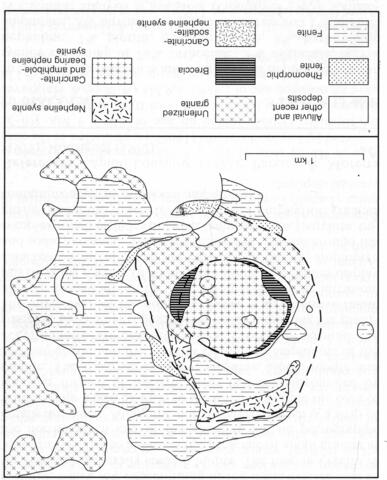stripes
Nejoio is an oval-shaped complex of 2x1.5 km with an area of fenites up to a kilometre wide extending around the eastern margin; there is little exposure to the west. The complex is essentially composed of feldspathoidal rocks the central area being dominated by nepheline syenites with pyroxene and amphibole around which is a ring of nepheline, cancrinite and sodalite syenites. Nepheline is ubiquitous but in some rocks cancrinite is of equal or greater abundance. Pyroxene, which is generally aegirine, is present in all rock types but in some varieties amphibole may be more abundant. The amphibole is, according to Rodrigues (1978), variably hornblende or magnesio-arfvedsonite. Sodalite is also present in all rocks as is biotite, titanite, apatite and an opaque phase. Minerals identified in some rocks include zircon, rosenbushite, fluorite, mosandrite, melanite, pyrochlore, lavenite and eudialyte. Chemical analyses, including some trace elements, are given by Rodrigues (1978). Arcuate areas of breccia occur within the feldspathoidal syenites and contain blocks of fenite, feldspathoidal syenite and tinguaite. The fenites are also briefly described and rock analyses given. One group are described as rheomorphic fenites. All the fenites contain quartz, alkali feldspar, plagioclase, biotite and aegirine, with hornblende, eckermannite and augite/aegirine-augite in most.
ALLSOPP, H.L. and HARGRAVES, R.B. 1985. Rb-Sr ages and palaeomagnetic data for some Angolan alkaline intrusives. Transactions of the Geological Society of South Africa, 88: 295-99.RODRIGUES, B. 1978. Processos de evolução magmática no complexo alcalino do Nejoio. Boletim do Museo e Laboratório Mineralógico e Geológico da Faculdade de Ciências, Universidade de Lisboa. 15: 1-171.

